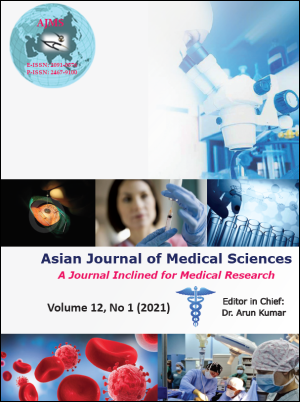Study of cord blood lipid profile at birth and its relation to gestational maturity and birth weight
Keywords:
Cord blood Lipid profile, Small gestational (SGA), Appropriate gestational age (AGA), NewbornAbstract
Background: Dyslipidemia is attributed for coronary artery diseases. Early detection of dyslipidemia in neonatal cord blood could help to identify possible future risk factors of coronary artery diseases in new born.
Aims and Objectives: This study was undertaken to compare lipid profile of small for gestational age (SGA) or preterm and appropriate for gestational age (AGA) or near-term neonates.
Material and Methods: A total of 60 neonates were included; of which 33 were AGA and 27 SGA neonates. 2 ml of blood was obtained from the umbilical vein immediately after cord clamping at delivery from each subject and kept in a plain vial, after the serum separation analyzed for biochemical parameters.
Results: In SGA neonates, mean TC (total cholesterol), TG (triglycerides) LDL (low density lipoprotein cholesterol), HDL (high density lipoprotein cholesterol) and triglycerides were 66.60±17.76 mg/dl,57.32±23.7 mg/dl, 54.06±20.11 mg/dl, 19.06±17.03mg/dl respectively. SGA neonates had more TC, TG and LDL than AGA neonates (P<0.05). There was significant difference in mean lipid profile between preterm andnear-term neonates. Thus, lipid profiles in SGA neonates in thisstudy are higher than that of AGAneonates.
Conclusion: It can be concluded that preterm babies are exposed to more hypercholesterolemia and potentially more atherogenic environment than their term counterparts.
Downloads
Downloads
Published
How to Cite
Issue
Section
License
Authors who publish with this journal agree to the following terms:
- The journal holds copyright and publishes the work under a Creative Commons CC-BY-NC license that permits use, distribution and reprduction in any medium, provided the original work is properly cited and is not used for commercial purposes. The journal should be recognised as the original publisher of this work.
- Authors are able to enter into separate, additional contractual arrangements for the non-exclusive distribution of the journal's published version of the work (e.g., post it to an institutional repository or publish it in a book), with an acknowledgement of its initial publication in this journal.
- Authors are permitted and encouraged to post their work online (e.g., in institutional repositories or on their website) prior to and during the submission process, as it can lead to productive exchanges, as well as earlier and greater citation of published work (See The Effect of Open Access).




